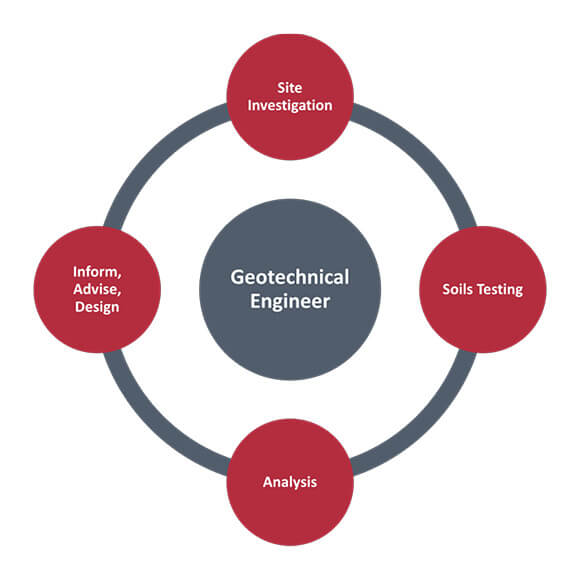The Greatest Guide To Geotheta
The Greatest Guide To Geotheta
Blog Article
The Ultimate Guide To Geotheta
Table of ContentsThe Ultimate Guide To GeothetaSome Of GeothetaNot known Details About Geotheta Not known Details About Geotheta The smart Trick of Geotheta That Nobody is Discussing

They conduct site examinations, gather samples, perform lab tests, and examine information to examine the viability of the ground for construction jobs - Consulting Engineer. Based upon their searchings for, geotechnical engineers supply referrals for foundation layout, incline security, maintaining structures, and mitigation of geotechnical hazards. They team up with various other professionals, such as designers, structural designers, and construction groups, to ensure that geotechnical factors to consider are integrated right into the general task style and execution
By examining the behavior and homes of dirt and rock, they can identify possible geotechnical dangers such as landslides, dirt negotiation, or slope instability. Their know-how aids prevent failures or crashes that can threaten lives and property. Below are some thorough duties and responsibilities of a geotechnical engineer: Website Examination: Geotechnical designers conduct site investigations to collect data on subsurface conditions.
They translate the information to recognize the homes and habits of the soil and rock, including their stamina, leaks in the structure, compaction features, and groundwater problems. Geotechnical Evaluation and Style: Geotechnical designers analyze the information collected throughout site investigations to assess the security and suitability of the site for building and construction tasks. They execute geotechnical calculations and modeling to evaluate aspects such as birthing capacity, negotiation, slope stability, lateral earth pressures, and groundwater circulation.
The Ultimate Guide To Geotheta
Structure Design: Geotechnical designers play a crucial duty in making structures that can securely support the designated structure. They evaluate the dirt problems and lots requirements to determine the ideal foundation type, such as superficial structures (e.g., footings), deep structures (e.g (http://peterjackson.mee.nu/do_you_ever_have_a_dream#c2153)., heaps), or specialized methods like dirt enhancement. They think about factors such as settlement limits, birthing ability, and soil-structure communication to create ideal structure layouts
They assess building and construction strategies, screen website activities, and perform area evaluations to validate that the style recommendations are followed. If unanticipated geotechnical concerns develop, they evaluate the circumstance and give recommendations for remediation or modifications to the style. Threat Analysis and Mitigation: Geotechnical engineers examine geotechnical dangers and threats associated with the job website, such as landslides, liquefaction, or dirt erosion.

Collaboration and Communication: Geotechnical engineers function closely with other experts entailed in a job, such as designers, structural designers, and construction groups. Effective interaction and partnership are vital to integrate geotechnical considerations right into the total project layout and construction procedure. Geotechnical engineers supply technical experience, response questions, and make certain that geotechnical needs are fulfilled.
10 Easy Facts About Geotheta Shown
Below are some sorts of geotechnical designers: Foundation Designer: Structure engineers concentrate on designing and assessing structures for frameworks. They evaluate the soil problems, lots needs, and website qualities to determine one of the most proper structure kind and style, such as shallow foundations, deep structures, or specialized strategies like heap foundations.
They examine the elements affecting incline security, such as soil buildings, groundwater problems, and slope geometry, and develop strategies to avoid slope failures and reduce dangers. Earthquake Designer: Earthquake engineers specialize in examining and developing structures to hold up against seismic pressures. They analyze the seismic threat of a website, assess dirt liquefaction capacity, and create seismic style criteria to guarantee the safety and security and strength of frameworks throughout quakes.
They execute area testing, gather examples, and analyze the gathered information to characterize the dirt homes, geologic formations, and groundwater problems at a website. Geotechnical Instrumentation Designer: Geotechnical instrumentation designers concentrate on monitoring and determining the behavior of soil, rock, and structures. They set up and maintain instrumentation systems that monitor elements such as dirt negotiation, groundwater degrees, incline activities, and architectural variations to analyze performance and supply early warnings of prospective problems.
Rumored Buzz on Geotheta
They carry out tests such as triaxial examinations, consolidation tests, straight shear examinations, and permeability examinations to collect information for geotechnical evaluation and style. Geosynthetics Engineer: Geosynthetics designers concentrate on the design and application of geosynthetic products, such as geotextiles, geogrids, and geomembranes. They utilize these materials to improve dirt security, strengthen slopes, offer drainage remedies, and control disintegration.
They often tend to be investigative people, which suggests they're intellectual, reflective, and analytical. They wonder, methodical, reasonable, logical, and sensible. A few of them are likewise social, suggesting they're kind, charitable, cooperative, client, caring, valuable, empathetic, skillful, and friendly. Does this seem like you? Take our totally free profession test to discover if geotechnical designer is one of your leading job suits.
In the office environment, geotechnical designers make use of specialized software devices to execute estimations, develop designs, and evaluate data. They prepare reports, review task requirements, connect with customers and employee, and coordinate job activities. The workplace setup supplies a favorable environment for research, evaluation, and partnership with other professionals associated with the project.
Our Geotheta PDFs
They often visit task read the article websites to perform site examinations, assess geotechnical problems, and gather data for evaluation. These brows through involve traveling to various places, in some cases in remote or difficult terrains. Geotechnical engineers may execute dirt sampling, conduct tests, and display building and construction activities to make certain that the geotechnical aspects of the job are being applied properly.
Geotechnical engineers additionally function in specialized geotechnical laboratories. Geotechnical laboratory engineers function thoroughly in these settings, dealing with testing devices, operating instruments, and recording data.
Report this page